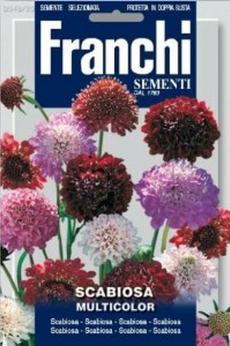
Scabiosa Multicolor aka Pincushion Flower
Scabiosa Multicolor aka Pincushion Flower This fragrant, old-fashioned flower comes in lovely shades of pink, blue-violet, lavender, and white. The popular powder puff blooms make a terrific cut flower that will allow you to fill your home with the wonderful scent. A Mediterranean native, this plant has a history of use as a folk remedy for skin disorders. The genus name "Scabiosa" means "scabies," referring to one of the skin complaints this plant was said to cure. The species name "atropurpurea" means "dark purple," one of the characteristic colors of its blooms. Each flower develops many pin-like stamens, explaining its common name of pincushion flower.
An old fashiond flower that will add and drama to the garden or meadow with Pincushion Flower. Bright, double flowers bloom in shades of pink, red and white, making a truly magnificent statement in the late season garden. The large blooms make great cut flowers and are butterfly magnets. The powder puff-like blooms make a long lasting cut flower, and are attractive to bees and butterflies. An easy-to-grow perennial for every garden. The plants themselves will reach a height of about 30 to 40 inches tall and make an excellent cut flower. Grown as an annual plant, Scabiosa will grow quickly, bloom profusely and die with the first killing frost.The flowers of Pincushion are fragrant and smell very sweet. The colors and fragrance are known to attract an array of beneficial insects to your garden including bumblebees, butterflies, hummingbirds & ladybugs as well. Pincushion flower seeds are easily sown indoors and directly outdoors, and the plants are fairly easy to maintain once established.Pincushion flowers are seen in natural settings and can be used in borders, flower beds and as stated above, as a cut flower for bouquets & vases. Dead heading will prolong the amount of time in which your Pincushion flowers will bloom. Collect Scabiosa atropurpurea seeds at the end of the season to regrow the following year, or allow the seeds to drop to the bare ground beneath.
Sowing: Direct sow in late fall or early spring, planting just below the surface of the soil. Seeds can also be started indoors 3-4 weeks before planting outdoors. Keep the soil lightly moist until germination, which usually takes 7-14 days. Keep seedlings lightly moist, and transplant them as soon as they have developed several leaves.
Growing: Water seedlings occasionally until they become established; mature plants grow best in fairly dry soil and do well in drought and poor soil. Deadheading or cutting back the plant will produce a new crop of blooms. This plant will self-seed unless cut back after flowering has finished. These flowers attract butterflies and bees.
Harvesting: For long-lasting cut flowers, choose stems with flowers that have just opened. Strip the foliage that will fall below the water level, and place in water immediately.
